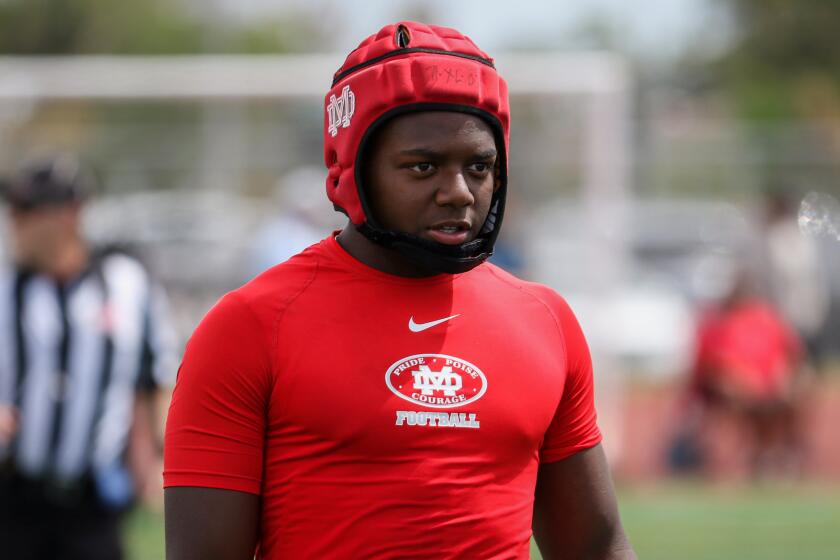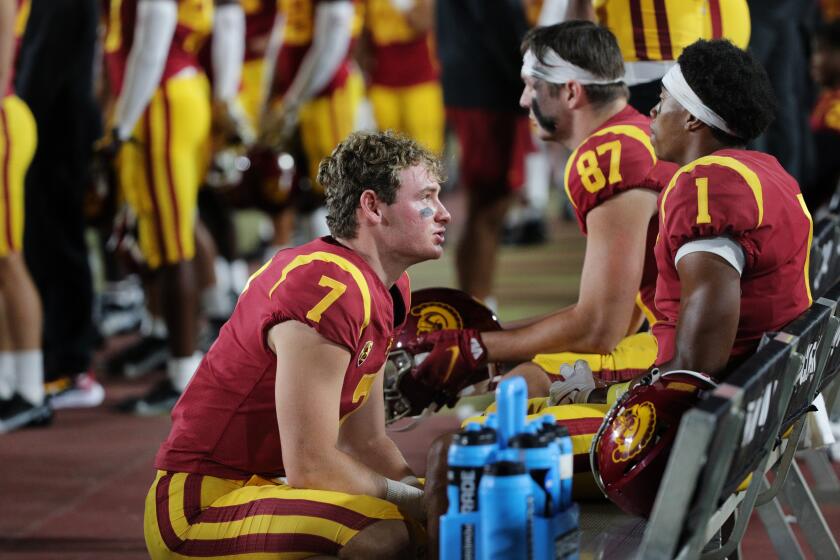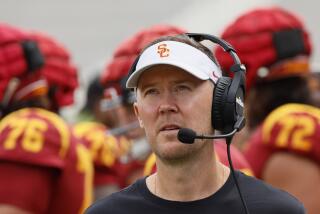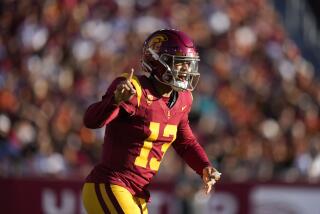USC’s Caleb Williams practicing more patience in the pocket
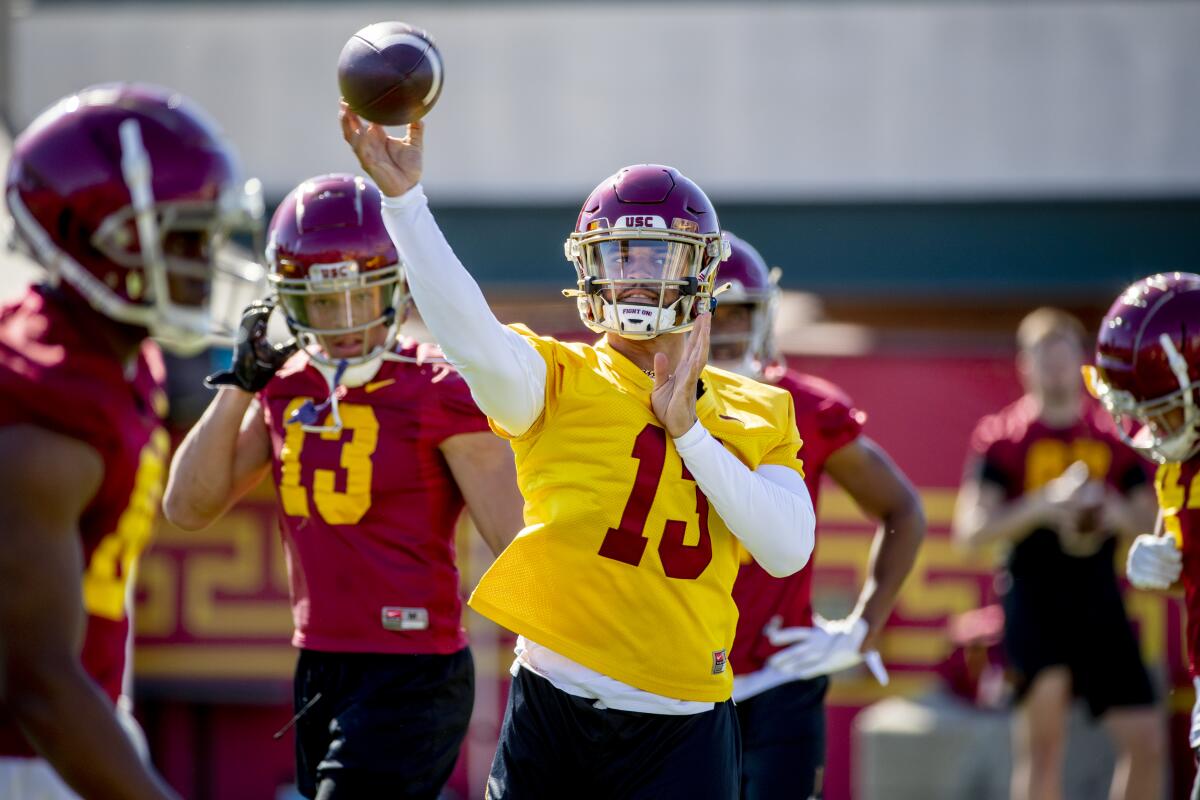
The mystifying moment when Caleb Williams announced his arrival to the college football masses came on a designed fourth-down run last October. Already trailing Texas 28-7, Oklahoma was on its own 34-yard line, desperate for some kind of spark. So on fourth and one, Lincoln Riley sent in his true freshman and asked him to make a play with his legs.
Such plays seemed to come naturally to Williams, who spent his youth football days as a running back before growing into the top dual-threat quarterback in the class of 2021. But within a split-second of the snap, the hole collapsed in front of him.
Three Texas defenders surrounded Williams in the backfield, but the freshman stayed patient. He slid suddenly to his left, deftly dodging one, then cut right, shaking loose from another. As he danced free, the Texas defense parted before him. Williams sped for a 66-yard touchdown run and never looked back, eventually leading Oklahoma to a stunning comeback that would cement his place atop the Sooners offense.
It was that superlative rushing ability that first set Williams on a path toward stardom last season, as he followed in the footsteps of other dual-threat quarterbacks who came before him in Riley’s offense, such as Kyler Murray and Jalen Hurts.
Yet at USC, where Williams now resides, there’s no such precedent. While the modern dual-threat quarterback has become commonplace across college football, USC has continued to march forth with a parade of pocket passers.
Not since the 1991 season, when Reggie Perry held the reins, have the Trojans entrusted their offense to a quarterback who could be classified as a dual threat. That season wound up an abject disaster, as Perry threw three touchdowns with 12 interceptions, and USC won just three games. Perry ultimately transitioned to safety after the season.
USC coaches say linebacker Raesjon Davis is improving while cornerback Domani Jackson made his spring practice debut on Thursday.
The program’s history before Perry isn’t exactly rich with capable running quarterbacks, either. Rodney Peete, who led the Trojans from 1985 to 1988, boasts 290 rushing attempts, the most by a USC quarterback, but only 415 yards rushing. Pat Haden had 514 yards rushing across his three seasons as quarterback before handing over the offense to Vince Evans, who finished with 533.
No modern USC passer has ever surpassed 300 yards rushing in a season. Pete Beathard came closest from 1961 to 1962, which still counts as the most prolific rushing stretch for a Trojans quarterback. Beathard accumulated 290 yards on the ground in both seasons, finishing his three-year career with 672 and 14 rushing touchdowns.
Williams is almost certain to shatter those statistical boundaries as a sophomore. Few college quarterbacks were more electric as ballcarriers last season, when Williams racked up 435 yards rushing and six touchdowns through a tantalizing combination of speed and brute force.
“He’s been able early in his career to be able to break some tackles and make some guys miss, which typically when a quarterback gets out, there can be a lot of space, there’s opportunity for big plays,” Riley said. “For a quarterback, he’s got pretty decent top-end speed. Had several long runs for us last year, explosive runs. He’s a guy where, defensively, he’s tough to account for. Having a guy on him is one thing, but sometimes getting him to the ground is a little tougher.”
Removing sacks from the equation, no college quarterback ran for more yards per attempt last season (8.7) than Williams. Nine of his designed runs went for 15 yards or more. Six of those went for more than 40 yards.
Many of his best runs, like the 66-yard touchdown against Texas, came after contact. He forced 22 missed tackles, according to Pro Football Focus, and averaged 4.95 yards per attempt after contact. Only two other quarterbacks bested that mark last season. One of them, Liberty’s Malik Willis, is expected to be the top passer picked in this month’s NFL draft.
There’s no reason to think that those tendencies will change at USC.
“When you’ve got a guy that can scramble the way he does and can take off and run and move the chains with his legs when things break down, or sometimes everybody’s kind of covered and you don’t like the read and it creates a little space there and you take off running the ball, it’s such a hard thing for the defense,” USC offensive coordinator Josh Henson said.
USC quarterback Miller Moss has been appreciative of the open communication and fair shot he’s gotten under new coach Lincoln Riley.
Over five seasons at Oklahoma, that wrinkle played a major role in Riley’s offense. Sooners quarterbacks accounted for an average of 143 rushing attempts per season over that stretch.
Even Baker Mayfield, who could hardly be classified as a dual threat, ran 97 times for 311 yards in Riley’s first season as coach. At USC, that performance would’ve cemented him as the most prolific running quarterback for one season.
That title is almost certain to belong to Williams after his sophomore season. This spring, the quarterback has been focused on running less, rather than more.
Looking back on his freshman season, Williams said he realized there were moments “where I was too quick to scramble.”
“I started to practice that last year especially, sitting in the pocket a little bit more, trusting the guys that are protecting me because that’s their job and I believe in them, I trust them,” Williams said.
As Riley sees it, that instinct to rely less on his legs is the appropriate next step in his development.
“I don’t want to harness those guys, but if people’s plan when Caleb plays is to try to keep him in the pocket, then he’s gotta be able to beat that,” Riley said. “And he’s fully capable of beating that. That’s always part of the progression of a young quarterback. Most guys learn more and more when to stay in there and when not to. He’s getting a feel for that, he’s pushing himself on it.”
That could mean fewer scrambles this fall, but for USC, a quarterback capable of scrambling at all will take some getting used to.
More to Read
Go beyond the scoreboard
Get the latest on L.A.'s teams in the daily Sports Report newsletter.
You may occasionally receive promotional content from the Los Angeles Times.

